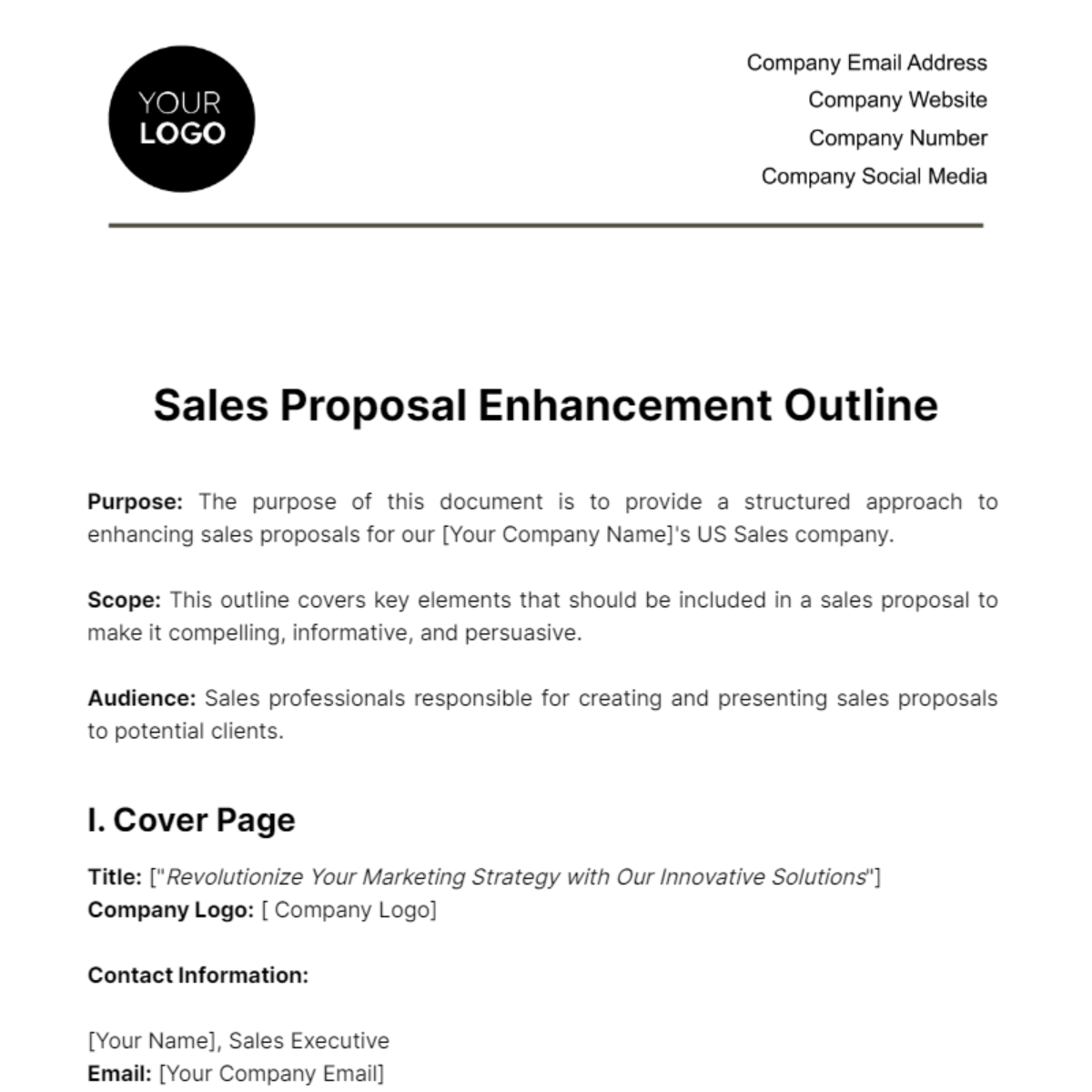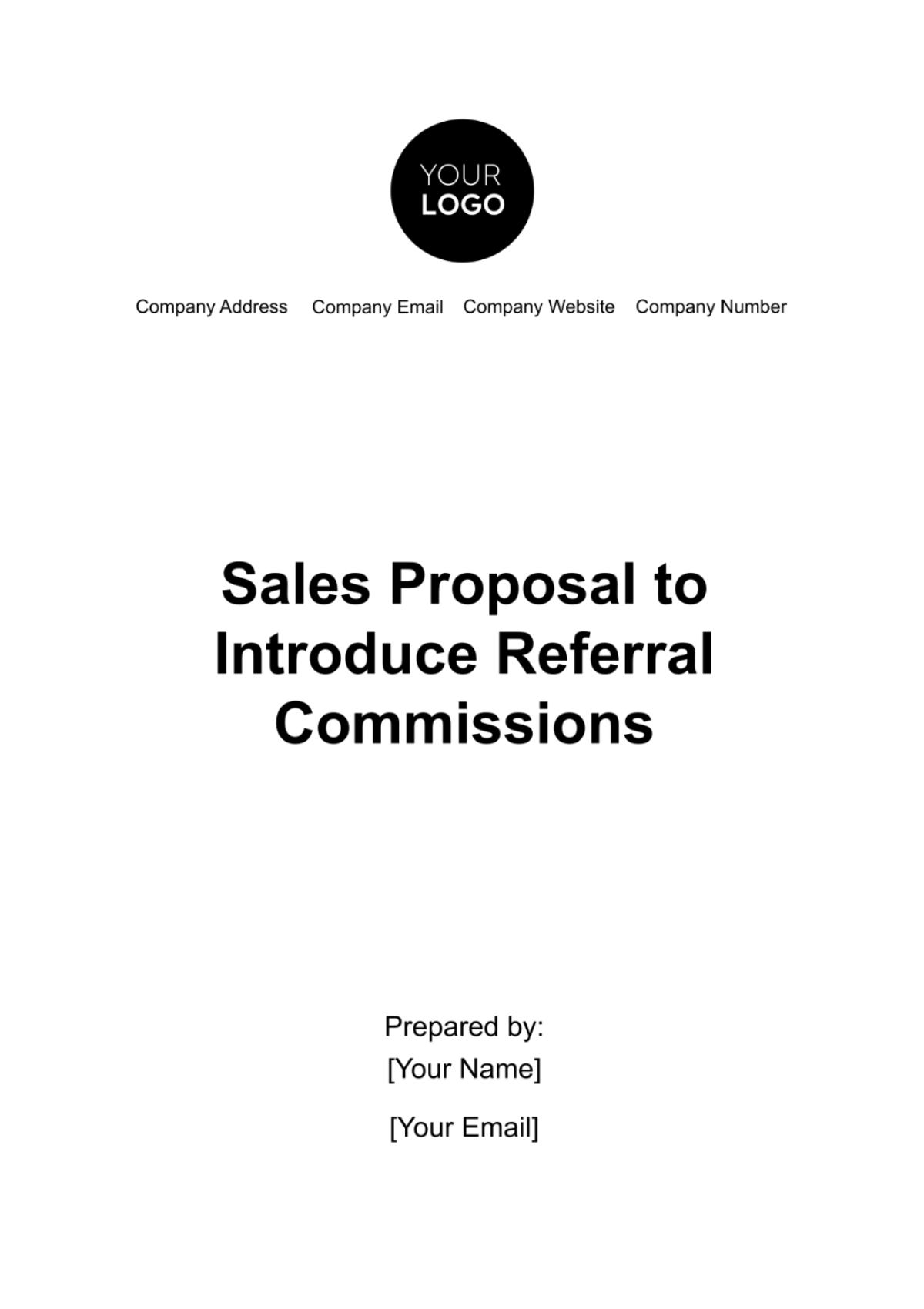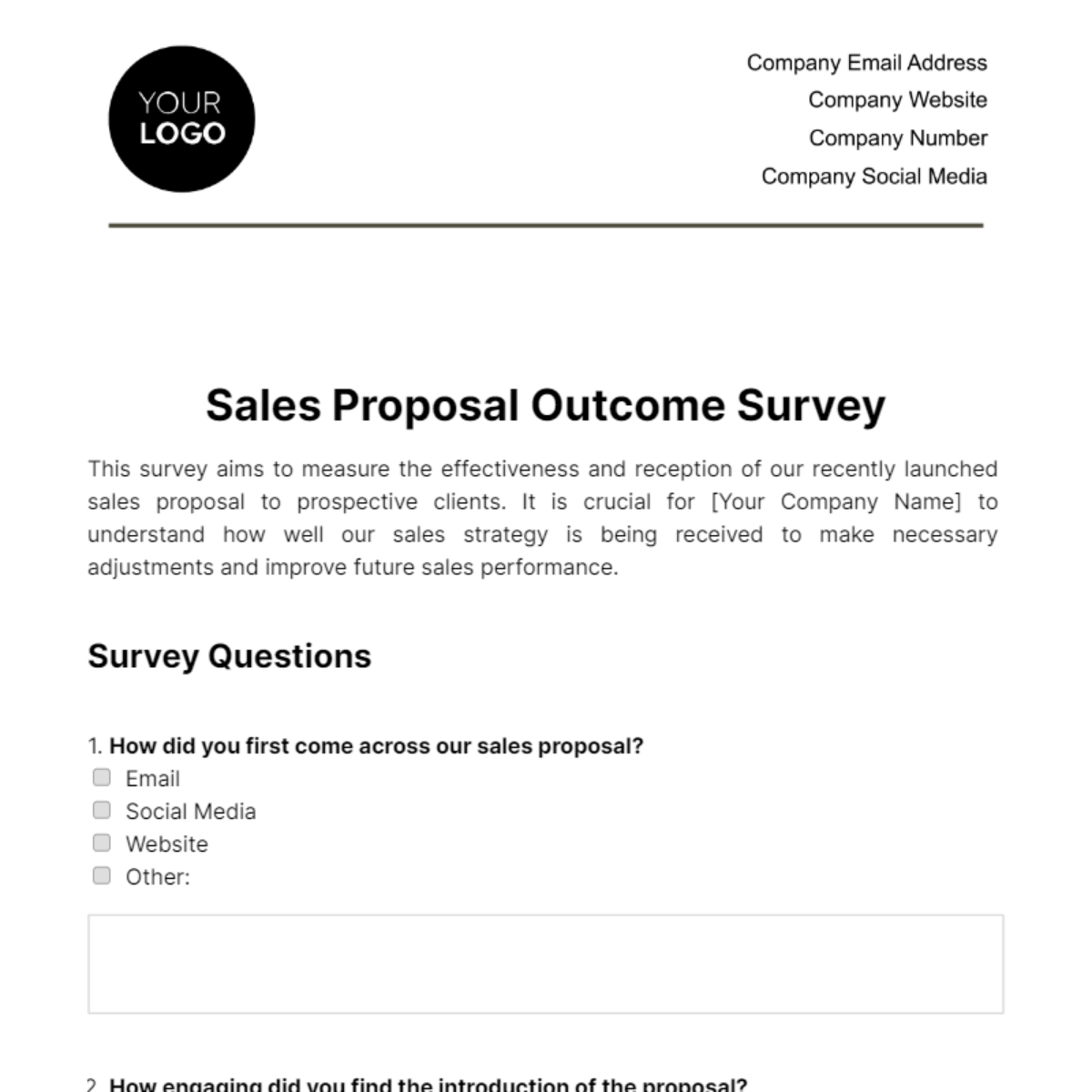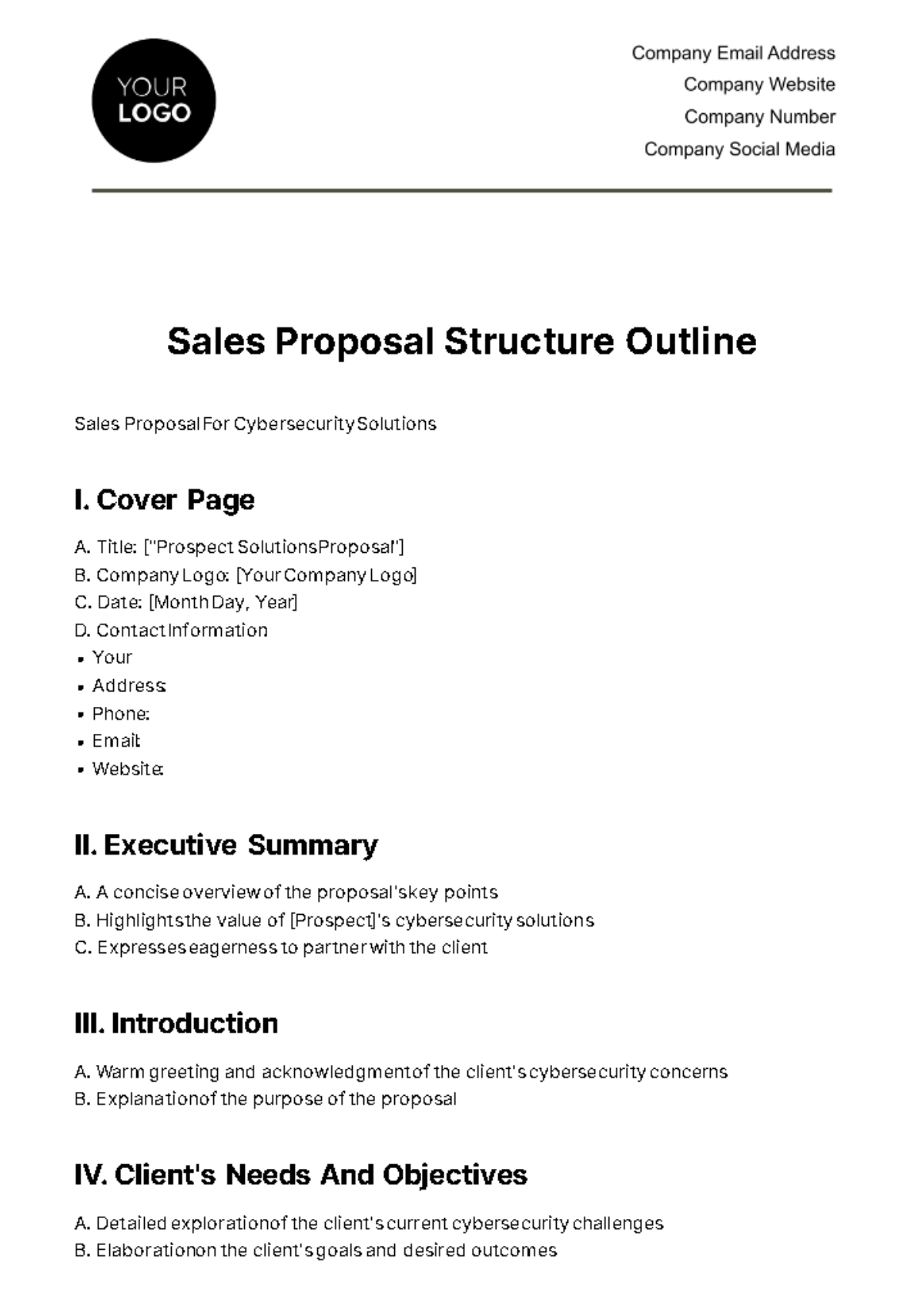Sales Product Launch Plan and Proposal
I. Introduction
The business environment is undergoing rapid changes with technological advancements and evolving consumer needs. To remain competitive, it is imperative for companies to adapt and introduce new products that cater to market demands. This Plan and Proposal outlines a comprehensive strategy that incorporates objectives, target markets, sales and marketing plans, as well as budget and financial projections. This initiative aims to secure [Your Company Name]'s market share while driving substantial revenue and customer engagement.
II. Executive Summary
This Plan and Proposal aims to present a well-structured and strategic approach to the successful launch of [Product Name], a cutting-edge solution crafted to meet the specific needs of our target market. This document provides in-depth analysis and actionable insights, including objectives, target market identification, multi-channel sales and marketing strategies, a detailed timeline with milestones, and a comprehensive budget.
III. Objectives
The objectives for the sales product launch of [Product Name] are designed to achieve both immediate and long-term success. They are strategically aligned with [Your Company Name]'s broader business goals and market expectations. The following objectives are prioritized for the product launch:
To Achieve Sales Revenue of $2 Million Within the First Quarter of the Product Launch.
To Attain a Customer Base of At Least 5,000 by the End of the Second Quarter.
To Achieve Brand Awareness and Recognition Among At Least 80% of the Target Market.
IV. Product Overview
[Your Company Name] is pleased to unveil our latest offering, the [Product Name], a game-changing appliance poised to reshape the home cleaning industry. Meticulously crafted, the [Product Name] amalgamates cutting-edge engineering with a deep understanding of consumer pain points.
A. Unique Selling Propositions
Advanced Cyclonic Technology: [Product Name] incorporates a multi-cyclonic system that delivers powerful, continuous suction.
Modular Design: [Product Name] features a modular build, offering attachments like a pet hair remover and an allergen filter, making it customizable to various household needs.
Energy-Efficient: Equipped with a high-efficiency motor, [Product Name] reduces energy consumption by up to 30% compared to traditional models.
B. Key Features and Benefits
Smart Navigation: The [Product Name] includes smart navigation capabilities facilitated by AI-driven sensors. This allows the appliance to maneuver around obstacles with ease, ensuring thorough and efficient cleaning.
HEPA Filtration: It features a High-Efficiency Particulate Air (HEPA) filter that captures 99.97% of airborne particles. This makes [Product Name] highly effective in allergen and dust removal, providing a cleaner and healthier living environment.
User-Friendly Interface: The control panel has a simple touchscreen interface with pre-set cleaning modes. Simplifies the user experience, allowing quick set-up and operation, making it ideal for users of all ages.
C. Technical Specifications
Presented in the following table are the specifications:
Aspect | Details |
Processor | Quad-core 1.8 GHz processor for swift and efficient performance. |
D. Competitive Advantage
While the home cleaning industry is saturated, [Product Name] sets a new paradigm by offering a well-rounded, technologically advanced solution. Its amalgamation of energy efficiency, cleaning effectiveness, and user-centric design makes it a compelling choice against competitors.
V. Target Market
The [Product Name] has been developed with a specific target market in mind. Our exhaustive market research has allowed us to identify several key segments that stand to benefit the most from this innovative home cleaning solution.
A. Demographic Profile
Age: The age range is 25 to 60 years old.
Income Level: Middle to high-income households
Geography: Urban and suburban areas across the United States
B. Psychographic Characteristics
Lifestyle: Health-conscious individuals who prioritize a clean and allergen-free environment.
Attitudes: Environmentally responsible consumers who appreciate energy-efficient products.
Behaviors: Tech-savvy individuals who are inclined to adopt smart home technologies.
C. Market Needs and Pain Points
Efficiency: A growing demand for quick and effective cleaning solutions.
Health and Safety: Increasing awareness of the importance of maintaining a home free of allergens and pollutants.
Ease of Use: A desire for user-friendly products that integrate seamlessly into daily life.
D. Market Size and Opportunity
According to our market research, the target market represents a significant percentage of the U.S. population, approximately 40 million households. With an average household willingness to spend $300 on a high-quality vacuum cleaner, the market potential stands at approximately $12 billion.
E. Competitive Landscape
The target market is currently being served by traditional vacuum cleaner brands, as well as newer, technology-focused entrants. However, a gap exists for a product that combines smart technology, user-friendliness, and eco-friendly features at a competitive price point.
By focusing on these key market segments and their associated needs, the [Product Name] is strategically positioned to capture significant market share. The product's unique features align closely with the target market's requirements, thereby providing a compelling value proposition.
VI. Sales Strategy
The overarching goal of the sales strategy for the [Product Name] is to penetrate the market swiftly, yet sustainably, while ensuring high customer satisfaction and long-term loyalty.
A. Sales Channels
Online Direct-to-Consumer: Utilizing our existing e-commerce platform and expanding to high-traffic third-party platforms such as Amazon to maximize online presence.
Retail Partnerships: Collaborating with established home appliance and electronics stores like Best Buy and Home Depot, as well as specialized local retailers to diversify points of sale.
B2B Sales: Actively focusing on corporate clients such as hotels, property management companies, and professional cleaning services that require bulk purchases.
B. Customer Acquisition
Inbound Marketing: Utilizing search engine optimization, pay-per-click advertising, content marketing, and social media platforms like Instagram and Facebook to drive organic traffic.
Outbound Marketing: Leveraging advanced customer segmentation and delivering personalized messaging through each channel to increase customer engagement rates and achieve higher conversion.
Promotions and Discounts: Deploying limited-time promotions such as "Buy One, Get One 50% Off" and special early-bird discounts for new product releases to stimulate initial sales.
C. Customer Retention
Loyalty Programs: Rolling out a tiered, points-based loyalty program that provides rewards like discounts, free shipping, and exclusive products, encouraging greater customer engagement.
After-Sales Service: Offering complimentary maintenance checks within the first year, extended warranties, and 24/7 customer support to exceed customer expectations.
Upselling and Cross-Selling: Proactively introducing customers to compatible attachments like pet hair removers and allergen filters, as well as related cleaning products, to enhance the utility of the main product.
D. Sales Timeline
The table below showcases the sales timeline with the respective KPIs:
Quarter | Activity | KPIs |
Q1 | Market Research | Market insights obtained |
Q2 | Pilot Launch | |
Q3 | Full-scale Launch | |
Q4 | Performance Evaluation |
E. Sales Forecast
The table below highlights the sales forecast per quarter:
Quarter | Units Sold | Revenue |
Q1 | 1,000 | $300,000 |
Q2 | ||
Q3 | ||
Q4 |
By implementing this multifaceted sales strategy, we aim to establish the [Product Name] as a market leader in its category. The plan has been designed to be adaptable in response to market feedback and evolving consumer needs.
VII. Marketing Channels
A. Digital Marketing
Social Media: Utilizing platforms such as Instagram, Facebook, and Twitter to showcase product features, share user testimonials, and run time-sensitive promotions. The objective is to engage a younger, tech-savvy audience while encouraging social sharing to increase organic reach and brand awareness.
Google Ads and SEO: Leveraging search engine marketing and optimization techniques like keyword research, ad creation, and on-site SEO improvements to increase the visibility of our website in search results. The aim is to capture potential customers who are actively searching for cleaning solutions online, thereby driving qualified traffic to our website.
Email Campaigns: Running targeted email campaigns that nurture leads through educational content, announce promotions, and deliver personalized product recommendations. The goal is to engage customers in a more personalized manner, thereby increasing click-through rates and fostering repeat purchases.
B. Traditional Marketing
TV Commercials: Crafting engaging commercials that highlight the product's unique selling points, to air during peak viewing hours for maximum exposure. The objective is to reach a broad and diverse audience to build brand recognition and encourage consideration.
Print Media: Utilizing respected newspapers and niche magazines to publish advertisements and feature articles that spotlight the [Product Name]. The aim is to reach an older, more traditional audience who still value print media as a credible source of information.
Outdoor Advertising: Deploying eye-catching billboards in high-traffic areas such as busy highways and proximate to major shopping centers. The goal is to create top-of-mind awareness among daily commuters and shoppers, thereby boosting brand recall and interest.
C. Partnerships and Collaborations
Influencer Partnerships: Partnering with influential figures in the home and lifestyle sector to showcase the [Product Name] in realistic, relatable settings. The objective is to leverage the credibility and audience reach of selected influencers to penetrate niche markets effectively.
Retail Partnerships: Coordinating in-store promotions and point-of-purchase displays in collaboration with our established retail partners to boost visibility and sales. The aim is to capture consumers’ attention at the critical moment of purchase decision-making, thereby encouraging impulse buying and increasing basket size.
VIII. Budget and Financial Projections
This part provides a meticulous breakdown of the anticipated costs and revenue streams associated with the launch and ongoing sales of the [Product Name]. The goal is to offer stakeholders a comprehensive understanding of the financial aspects of this endeavor, thereby enabling informed decision-making and planning.
A. Initial Costs
The initial costs per item are outlined below:
Item | Cost |
Product Development | $200,000 |
Marketing and Advertising | |
Inventory and Logistics | |
TOTAL: |
B. Recurring Expenses
Presented below are expenses in a monthly basis:
Item | Cost (Monthly) |
Employee Salaries | $60,000 |
Marketing and Maintenance | |
Inventory Management | |
TOTAL: |
C. Revenue Projections
The projected revenue are specified in the following table:
Revenue Stream | Annual Revenue |
Direct-to-Consumer Sales | $3,000,000 |
Retail Partnerships | |
B2B Sales | |
TOTAL: |
IX. Conclusion
In summary, this Plan and Proposal outlines a strategic framework for the successful launch and ongoing sales of the [Product Name]. It encompasses all crucial aspects of the initiative, including product development, target market analysis, sales and marketing strategies, and a meticulous budget and financial projection. The document aims to provide stakeholders with a holistic view of the project, thereby enabling well-informed decision-making.

















































